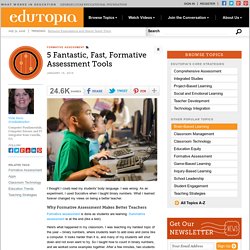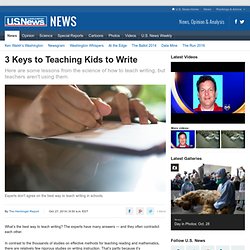

5 Fantastic, Fast, Formative Assessment Tools. I thought I could read my students' body language.

I was wrong. As an experiment, I used Socrative when I taught binary numbers. What I learned forever changed my views on being a better teacher. Why Formative Assessment Makes Better Teachers Formative assessment is done as students are learning. 53 Ways to Check for Understanding. The-inquiry-process.gif (GIF Image, 551 × 484 pixels) New Teachers: Resource Roundup. Teacher: We are trying to close the achievement gap all wrong. On April 27, 2014, hundreds of high school students and other supporters participated in the March to Close the Gap.

They walked from the Montgomery County Public Schools board of education building to Courthouse Square to in order to raise the awareness and garner support to close the achievement gap. They are pictured leaving the Montgomery County Public Schools building. (Photo by Sarah L. Voisin/The Washington Post) You can’t have a conversation about education reform without the words “achievement gap” coming in at some point, along with specific plans on how to close it. By James Boutin When I started teaching, I had a radically different understanding of public schools and their purpose than I do today. Let me tell you about a student I once taught. Many days, Guillermo slept through class.
A few years after I had him in class, I learned from our school counselor that the reason he slept in class so often was that his mom had relocated their family about 25 miles from our school. Metacognition: The Gift That Keeps Giving. Editor's note: This post is co-authored by Marcus Conyers who, with Donna Wilson, is co-developer of the M.S. and Ed.S.

Brain-Based Teaching degree programs at Nova Southeastern University. They have written several books, including Five Big Ideas for Effective Teaching: Connecting Mind, Brain, and Education Research to Classroom Practice. Students who succeed academically often rely on being able to think effectively and independently in order to take charge of their learning. These students have mastered fundamental but crucial skills such as keeping their workspace organized, completing tasks on schedule, making a plan for learning, monitoring their learning path, and recognizing when it might be useful to change course. They do not need to rely on their teacher as much as others who depend on more guidance to initiate learning tasks and monitor their progress.
Metacognition in the Brain How to Teach Students to Be More Metacognitive Reference. 30 Techniques to Quiet a Noisy Class. One day, in front 36 riotous sophomores, I clutched my chest and dropped to my knees like Sergeant Elias at the end of Platoon.

Instantly, dead silence and open mouths replaced classroom Armageddon. Standing up like nothing had happened, I said, "Thanks for your attention -- let's talk about love poems. " I never used that stunt again. After all, should a real emergency occur, it would be better if students call 911 rather than post my motionless body on YouTube. I've thought this through. Most teachers use silencing methods, such as flicking the lights, ringing a call bell (see Teacher Tipster's charming video on the subject), raising two fingers, saying "Attention, class," or using Harry Wong's Give Me 5 -- a command for students to: Focus their eyes on the speaker Be quiet Be still Empty their hands Listen. There is also the "three fingers" version, which stands for stop, look, and listen.
Lesser known techniques are described below and categorized by grade bands: Call and Response. Why Teaching Kindness in Schools Is Essential to Reduce Bullying. Phrases like "random acts of kindness" and "pay it forward" have become popular terms in modern society.

This could perhaps be best explained by those who have identified a deficiency in their lives that can only be fulfilled by altruism. It seems there are good reasons why we can't get enough of those addictive, feel-good emotions, as scientific studies prove there are many physical, emotional, and mental health benefits associated with kindness. As minds and bodies grow, it’s abundantly clear that children require a healthy dose of the warm-and-fuzzies to thrive as healthy, happy, well-rounded individuals. Patty O'Grady, PhD, an expert in neuroscience, emotional learning, and positive psychology, specializes in education.
She reports: Kindness changes the brain by the experience of kindness. A great number of benefits have been reported to support teaching kindness in schools, best summed up by the following. Happy, Caring Children Greater Sense of Belonging and Improved Self-Esteem. 3 Keys to Teaching Kids to Write. What’s the best way to teach writing?

The experts have many answers — and they often contradict each other. In contrast to the thousands of studies on effective methods for teaching reading and mathematics, there are relatively few rigorous studies on writing instruction.